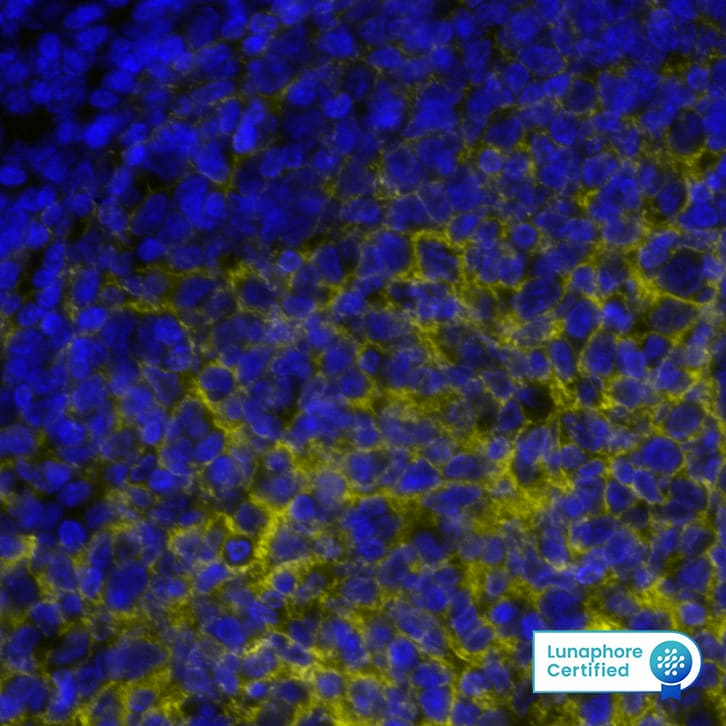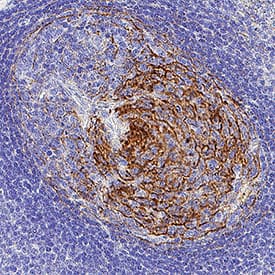Human VCAM-1/CD106 Antibody
R&D Systems, part of Bio-Techne | Catalog # MAB11671


Conjugate
Catalog #
Key Product Details
Species Reactivity
Human
Applications
Multiplex Immunofluorescence, Immunohistochemistry
Label
Unconjugated
Antibody Source
Monoclonal Mouse IgG1 Clone # 1027406
Product Specifications
Immunogen
Chinese Hamster Ovary cell line, CHO-derived human VCAM-1/CD106
Phe25-Glu698
Accession # P19320
Phe25-Glu698
Accession # P19320
Specificity
Detects recombinant human VCAM-1 in Direct ELISA.
Clonality
Monoclonal
Host
Mouse
Isotype
IgG1
Scientific Data Images for Human VCAM-1/CD106 Antibody
Detection of VCAM1 in Human Tonsil via seqIF™ staining on COMET™
VCAM1 was detected in immersion fixed paraffin-embedded sections of human Tonsil using Mouse Anti-Human VCAM1, Monoclonal Antibody (Catalog #MAB11671) at 15ug/mL at 37 ° Celsius for 4 minutes. Before incubation with the primary antibody, tissue underwent an all-in-one dewaxing and antigen retrieval preprocessing using PreTreatment Module (PT Module) and Dewax and HIER Buffer H (pH 9; Epredia Catalog # TA-999-DHBH).Tissue was stained using the Alexa Fluor™ 647 Goat anti-Mouse IgG Secondary Antibody at 1:200 at 37 ° Celsius for 2 minutes. (Yellow; Lunaphore Catalog # DR647MS) and counterstained with DAPI (blue; Lunaphore Catalog # DR100). Specific staining was localized to the membrane. Protocol available in COMET™ Panel Builder.Detection of VCAM-1/CD106 in Human Tonsil.
VCAM-1/CD106 was detected in immersion fixed paraffin-embedded sections of human tonsil using Mouse Anti-Human VCAM-1/CD106 Monoclonal Antibody (Catalog # MAB11671) at 5 µg/ml for 1 hour at room temperature followed by incubation with the Anti-Mouse IgG VisUCyte™ HRP Polymer Antibody (Catalog # VC001) or the HRP-conjugated Anti-Mouse IgG Secondary Antibody (Catalog # HAF007). Before incubation with the primary antibody, tissue was subjected to heat-induced epitope retrieval using VisUCyte Antigen Retrieval Reagent-Basic (Catalog # VCTS021). Tissue was stained using DAB (brown) and counterstained with hematoxylin (blue). Specific staining was localized to the cell membrane. View our protocol for IHC Staining with VisUCyte HRP Polymer Detection Reagents.Applications for Human VCAM-1/CD106 Antibody
Application
Recommended Usage
Immunohistochemistry
3-25 µg/mL
Sample: Immersion fixed paraffin-embedded sections of human tonsil
Sample: Immersion fixed paraffin-embedded sections of human tonsil
Multiplex Immunofluorescence
15 µg/mL
Sample: Immersion fixed paraffin-embedded sections of human tonsil
Sample: Immersion fixed paraffin-embedded sections of human tonsil
Formulation, Preparation, and Storage
Purification
Protein A or G purified from cell culture supernatant
Reconstitution
Reconstitute lyophilized material at 0.2 mg/ml in sterile PBS. For liquid material, refer to CoA for concentration.
Formulation
Lyophilized from a 0.2 μm filtered solution in PBS with Trehalose.
Shipping
Lyophilized product is shipped at ambient temperature. Liquid small pack size (-SP) is shipped with polar packs. Upon receipt, store immediately at the temperature recommended below.
Stability & Storage
Use a manual defrost freezer and avoid repeated freeze-thaw cycles.
- 12 months from date of receipt, -20 to -70 °C as supplied.
- 1 month, 2 to 8 °C under sterile conditions after reconstitution.
- 6 months, -20 to -70 °C under sterile conditions after reconstitution.
Background: VCAM-1/CD106
References
- Vonderheide, R.H. et al. (1994) J. Cell Biol. 125:215.
- Cybulsky, M.I. et al. (1991) Proc. Natl. Acad. Sci. USA 88:7859.
- Luster, A.D. et al. (2005) Nat. Immunol. 6:1182.
- Osborn, L. et al. (1989) Cell 59:1203
- Langer. H.F. et al. 2009. J Cell Mol Med. 13:1211.
- Willeit.K. et al. 2017. JAMA Cardiol. 2:516.
- Lo Iacono.O. et al. 2008. Liver Int. 28:1129.
- Wu.T.C. et al. 2007. Cancer Research. 67:6003
Long Name
Vascular Cell Adhesion Molecule 1
Alternate Names
CD106, VCAM1
Gene Symbol
VCAM1
UniProt
Additional VCAM-1/CD106 Products
Product Documents for Human VCAM-1/CD106 Antibody
Product Specific Notices for Human VCAM-1/CD106 Antibody
For research use only
